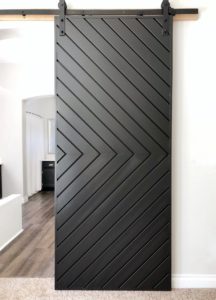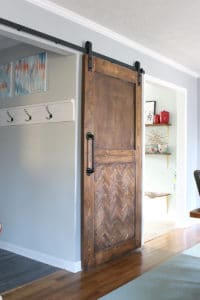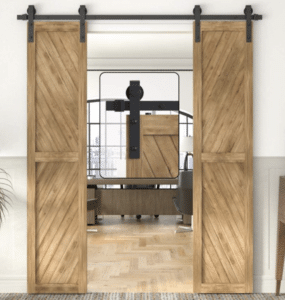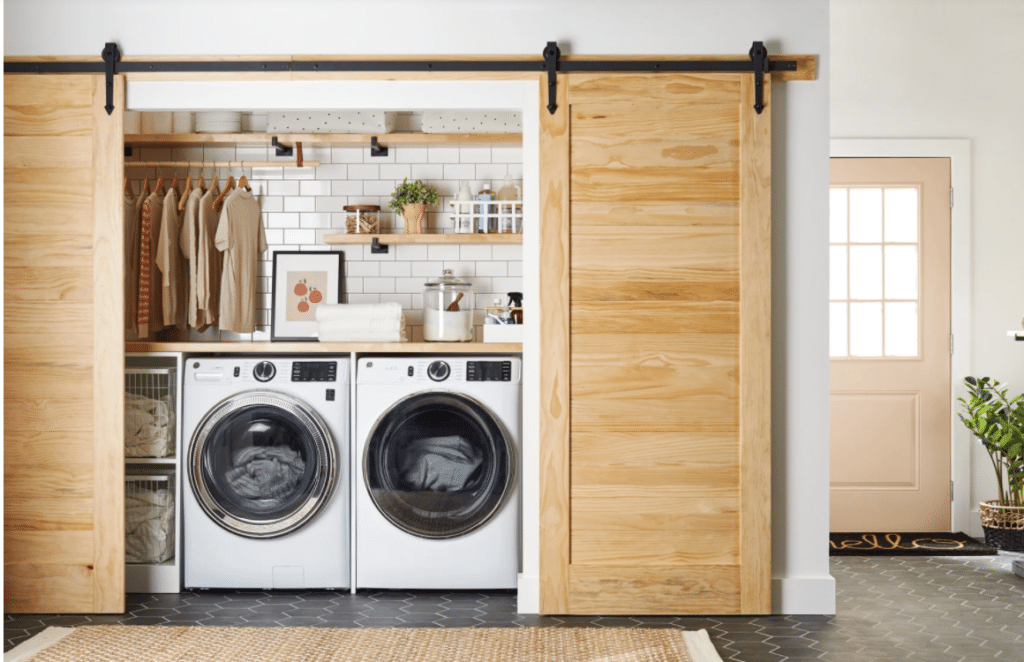DIY Sliding Barn Doors (Types, DIY Hardware, and Free Plans)
A couple years ago, I made our first ever rustic herringbone sliding barn door for the bathroom in our primary bedroom. Ever since then, I’ve had tons of questions come in about it. So, I thought it would be a great time to share what I’ve learned through building and installing our own sliding door!
I have rounded up more free plans to build your own barn door, what hardware to use, and how to choose the kind of sliding barn door that’s right for your home.
Types of Sliding Barn Doors
When choosing which type of sliding barn door you want for your home, you should think about the overall aesthetic of your home, not just the room it is going in. What style would fit the room and your home well? Some examples of styles of sliding doors are rustic, modern, herringbone, chevron, shiplap, and double sliding barn doors.
Let’s look at some example below! I’ve rounded up lots of free plans to build your own sliding doors, depending on which style you choose.
Rustic Sliding Barn Door

These are probably the most “classic” style of sliding barn door, due to the ease of making your own.
Disclaimer: This site contains product affiliate links. We may receive a commission if you make a purchase after clicking on one of these links.
They are typically made out of stained pinewood. You can find hardware for rustic sliding doors here. The hardware will typically have the “found” look. Vintage hardware goes great with this style of sliding barn door.
You can find a tutorial to make your own rustic sliding barn door here.
Modern Sliding Barn Door

Modern sliding barn doors are on the rise with interiors going more black and white. In fact, I plan on building one for our new house since my interiors will be black, white, and wood tones.
I will be doing a wooden sliding door painted black in our primary bedroom, but black iron sliding doors are popular now, too. The benefit to these is that these modern sliding barn doors often come with frosted windows, which could work great for rooms that don’t need privacy.
These sliding doors are also a great option if you’re looking to make a lightweight sliding barn door too. For example, you could use an old hollow door to make a lightweight sliding door.
You can buy a modern sliding door and hardware here.
Herringbone Sliding Barn Door

Herringbone Sliding Barn doors will take a few more meticulous cuts to get the desired look, but it is absolutely achievable. Here is a great tutorial to make your own herringbone door. You can get this look with just a basic miter saw and would be a great project to test out those new found building skills.
What I like about these, is you can make these as rustic or modern as you want. You can sand it and paint it black for the modern look, or stain it to go for the more rustic look.
Similar handle can be found here.
Chevron Sliding Barn Door

Similar to herringbone doors, chevron doors create a fun aesthetic to your space. They have a modern vibe with the clean, crisp line. The door I made has a similar chevron feel on the bottom. Here is another great tutorial to make a chevron sliding barn door.
Q: What’s the difference between herringbone and chevron?
A: The main difference is that herringbone pattern has ends that are overlapping, whereas chevron pattern has the ends cut at a 90 degree angle to make a straight line.
Shiplap Sliding Barn Door

Shiplap is a great option to add texture and design to a door. With it being tongue and groove, you can easily make clean lines and cover the door with the wood for not much money. Shiplap is also a great idea to create a herringbone or chevron design.
Home Depot sells lots of paintable shiplap options.
Learn how to build a shiplap sliding barn door here!
Double Sliding Barn Door

Double sliding barn doors are a great option if you don’t have the wall space for a whole door on either side of the door opening. They’re also great for those that love symmetry (ahem…hi, it’s me).
In fact, not only am I making a modern black barn door for our new house, I’m planning on it being double barn doors that will meet in the middle.
You can purchase the hardware in the picture here!
Since my very first post on how we made our own sliding barn door years ago, I’ve been asked quite a few questions about it. So, I thought I’d tackle those questions here.
Q: How much bigger should a barn door be than the opening?
A: You will want to make your door 1″ wider than the door casing on both sides and 1″ taller than the top of the casing. So, if the opening of your door is 32″ wide, and the outside of the casing is 36″ wide, make your door 38″ wide.
The reason for this is aesthetics and privacy. When the door is shut, you will want your barn door to cover the door casing. If it didn’t, the door would look too small for the space.
As for privacy, just by the nature of sliding doors, there is a gap between the door and the wall. The more overhang on the outside of the opening of the door, the more privacy will be achieved.
Q: What is the best wood for barn door?
A: The answer to this depends on what style door you choose. If you are making a shiplap door, you will need the correct board for the shiplap to attach to (I would recommend 3/4″ thick plywood). Do not use MDF for this and you can read about why here.
Q: Are barn doors good for laundry room?
A: Sliding barn doors can be a great option for laundry rooms. The first reason why is because your laundry room most likely will not need a lock on it. Locks for sliding barn doors are notoriously tricky, so if you are able to avoid installing them, that is a major plus.

There are, however, a couple things to think about if you are considering making a sliding barn door for your laundry room. The first is noise. If you have a washer or dryer that is particularly loud, the barn door will most likely do a poor job of cutting down on the sound. This is because of the gap that’s created between the wall and the door and will never be completely closed.
Another thing to consider when you make your own sliding barn door is the wall space on the side of the door that the door will take up when opened. Make sure you have ample wall space for this, which can be hindering since laundry rooms are typically in a tighter space.
Q: Should barn door be on inside or outside of room?
A: In my opinion, a barn door should be on the outside of a room if it is used mainly for aesthetics (laundry room, entrance to game room, etc). Why spend all of your time making your own beautiful sliding door to have just the back side showing when you shut it?
You will also want to think about locks if it is being used in a space that it’s needed, like a bathroom for example. Typical sliding barn door locking hardware like this set is meant to be installed on the back of a door. So, unless you want the lock to be on the front of your door, you will want to install your door on the outside of the room so you can lock it from the back of the door, inside the room.
Q: How do you shiplap a door?
A: Shiplapping a barn door is a great, easy way to add character to a door. You can install the shiplap vertically or horizontally to your barn door and achieve really beautiful results.
In order to properly install the shiplap to the barn door, you will need a backer. A great option for this would be plywood. You can use MDF as long as it isn’t holding too much weight.
Here is a great tutorial for you to shiplap a door.
This post contains affiliate links.

Suzie Wible
Suzie has shared her knowledge for over 10 years about building furniture, painting techniques, how to build your dream home, and basic to advanced woodworking skills. Through this blog, readers will feel empowered to create a home and products they love too.
One Comment
Comments are closed.